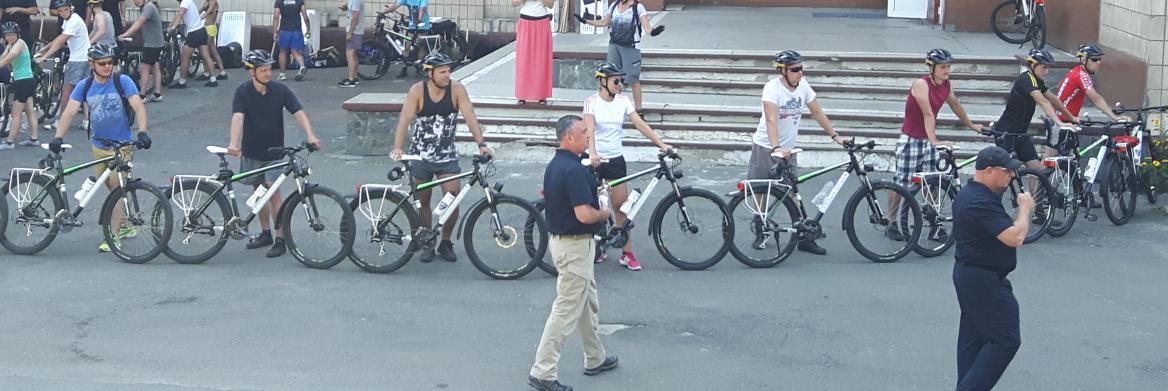Last July, as a member of the Calgary Police Service's (CPS) Mountain Bike Unit, I went to Kyiv, Ukraine, as a consultant for Agriteam Canada — a partner with the Canadian Department of Foreign Affairs and the European Union Advisory Mission. The purpose was to support the reform of the patrol police in the Ukraine.
The RCMP, along with other Canadian police agencies, has had a presence advising Ukraine's Interior Ministry on the security sector since 2015. Experienced officers have been invited to work closely with the Ukraine National Police to transform its police service into an effective, accountable and community-focused agency that embodies public trust.
Canada has already contributed $5 million for uniforms, body cameras and training on such topics as control tactics, leadership and public affairs. In this instance, the CPS created a bike patrol training program for the Ukraine patrol police.
One of the goals of the Ukraine National Police force is to improve public relations and perceptions. With the success of mountain bike patrols in our own cities and communities in Canada, the training was able to show practical examples of how well mountain bikes can be used at public events, pedestrian areas and regular community patrols.
Changing perceptions
Fifty Ukraine patrol officers from various areas across the country were instructed in the basics of police bike patrol. The Ukraine program focused on slow speed skills, riding in pairs and groups, and bike officer–subject contact strategies.
Prior to the re-establishment of the Ukraine National Police force in 2015, citizens generally avoided police officers. There's no doubt that the current dressed-down, yet authoritative appearance of a bicycle officer's shorts and shirt provides a less intimidating experience for the public. In fact, bike patrols create twice as many positive contacts with the public than vehicle patrols do. Bike officers are more approachable, providing opportunities for new impressions. The Ukraine National Police force is new in its inception with well-educated, strongly engaged and enthusiastic officers. They were appreciative of the training and asked many questions including if it was acceptable to shake hands with members of the public. The training emphasized the importance of being approachable, friendly and community-oriented.
While essential for community policing initiatives, bike patrols can be integrated into other operations and initiatives. Bike patrol is a very effective way to deal with crowds and protests. A portion of the training also included teaching the Ukraine officers how to use their bikes as a form of public order. Even in unruly crowd situations, bike officers have a unique ability to develop a rapport with the public. These officers are often able to effectively defuse situations before they progress. The patrol officers on bikes learned that they can maintain swift response times and use their bicycles as barriers in many situations.
During the training, the patrol officers viewed videos and photos of Canadian police experiences with bikes at G8, the Calgary Flames Red Mile (a stretch of road where thousands of hockey fans congregate) and anti-racism protests with very large and potentially violent crowds. They could see how effective and professional the bike officers were. And they enjoyed seeing how bike patrol officers use social media in their work, including selfies of officers interacting with the public.
While Olympic-bound athletes were being announced on a stage in Kyiv only one week following the patrol officers' training, members of the crowd continuously stopped the officers to interact, converse and have pictures taken with them. These newly trained Ukrainian mountain bike patrol officers — the same ones who had been asking if it was acceptable to shake hands with members of the public — were already making an impact in their community.
Not lost in translation
Teaching in a country in which little English is spoken provided some challenges and was probably the hardest part about offering this trainng. Each sentence of instruction was followed by translation from an experienced translator. It was tricky, but after a day or so, we got into a rhythm of using a translator to effectively communicate lesson plans.
With communication such a big piece of policing and instructing, there was initially a concern that the important communication approaches and concepts would not come through in the translation. Fortunately, a civilian employee and communications professional with the Calgary Police Service had previously travelled to Kyiv to advise police on public outreach, public communications and police/community engagement. With many officers already trained in media relations, they knew and understood the value of open communication with both the public and media, and this came through well in the translation.
The training provided an opportunity to grow and exchange ideas and expertise. By teaching a bike patrol program with a community-policing approach — the philosophy that police officers are civilians, not soldiers, and that a police force is a community organization responsible to the community — the training by Canadian police officers has hopefully made a positive impact on Ukraine's police patrol.
Sgt. Katrina O'Reilly has been a bike officer for more than half of her 20-year career with the Calgary Police Service. She also teaches law enforcement bike patrol to many peace officers and police officers in Western Canada and the United States.
